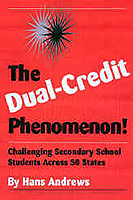Key Information
The Dual-Credit Phenomenon! Challenging Secondary School Students Across 50 States, By Hans A. Andrews
2001 [ISBN: 1-58107-044-6; 132 pages soft cover; 5 1/4 by 8/14] $16.95
 The Dual-Credit Phenomenon is the first comprehensive study published on this fascinating new nationally-growing educational movement. This program allows those bright students to take college level classes that secondary schools now count toward high school diploma completion. In short, the student gets credit both ways. Other students enroll in technical and vocational programs with the community colleges and seek out potential new job skills or a career choice.
The Dual-Credit Phenomenon is the first comprehensive study published on this fascinating new nationally-growing educational movement. This program allows those bright students to take college level classes that secondary schools now count toward high school diploma completion. In short, the student gets credit both ways. Other students enroll in technical and vocational programs with the community colleges and seek out potential new job skills or a career choice.
The dual-credit movement is one of the most significant educational innovations to take place over the past 50 years. It adds a significant new dimension to the school reform movement started in the 1980s. It brings secondary schools and higher education into the same arena in terms of improving learning opportunities for students.
Many critics of the secondary school system in America are suggesting the last two years of high school are a waste of time for many students. In addition, leaders in almost every state’s educational system along with state legislators are looking for ways to shorten the time it takes to earn a baccalaureate degree. It is common for students to graduate in four-and-one-half to five-and-one-half years rather than the four intended for the degree.
Community colleges and a few universities have undertaken reform through the creative program of dual-credit. This program allows those bright students to take college level classes that secondary schools now count toward high school diploma completion. In short, the student gets credit both ways. Other students enroll in technical and vocational programs with the community colleges and seek out potential new job skills or a career choice.
The state of Washington, for example, has analyzed the state’s appropriation savings to be $38 million or more a year in their dual-credit program titled “Running Start.” This figure increases to $50 million a year saved when the $12 million saved in tuition by parents and students is added to the formula. Other states are just now beginning to see the savings when students can complete two years of schooling (senior year and first year of college) in one year.
Over 40 states have now identified dual-credit programs taking place in their states. Students, parents, administrators and legislators are demanding programs that challenge these students. The Dual-Credit Phenomenon is the first comprehensive study published on this fascinating new nationally-growing educational movement. The dual-credit movement is one of the most significant educational innovations to take place over the past 50 years. It adds a significant new dimension to the school reform movement started in the 1980s. It brings secondary schools and higher education into the same arena in terms of improving learning opportunities for students.
The Contents
Foreword
Chapter I: Dual-Credit: A Major 21st Century Phenomenon
Chapter II: Dual-Credit: State Plans
Chapter III: State Plans: College Campus and High School Campus Options
Chapter IV: State Plans: College Campus Programs
Chapter V: Quality Issues: Lessons Learned from Missouri and Florida
Chapter VI: The Dual-Credit Explosion: Illinois, and Other States
Chapter VII: Outcomes of Dual-Credit for Students
Chapter VIII: Dual-Credit: Local, State, and National Research Needs
Chapter IX: Summary…Prognosis
X: Bibliography
Appendix A: Sample Contract with Secondary School
Appendix B: Marquette High School – IVCC Dual-Credit Survey
The Author
Hans A. Andrews is the former President of Olney Central College in Southeastern Illinois. He has a Bachelor of Science degree (1960) in Business Education from Central Michigan University. He received a Master’s in Arts degree in Counseling and Guidance in 1963 from Michigan State University. In 1971 he earned his Ed.D. degree in Counseling Psychology and Higher Education Administration from the University of Missouri-Columbia.
Andrews’ other professional roles in community colleges have been primarily in administration. He was Dean of Instruction at Illinois Valley Community College, and Vice President for Community and Student Services at Kellogg Community College. That position was preceded by the positions of Dean of Community Services, Evening College Dean, and Evening College Counselor also at Kellogg Community College. These positions were preceded by five years of high school teaching and roles as Director of Counseling and Guidance in two secondary schools. Dr. Andrews also taught part-time as an adjunct instructor in the Department of Curriculum and Instruction at Illinois State University.
Over the past 30 years Andrews has published three books, Evaluating for Excellence, Merit in Education and Teachers Can Be Fired: The Quest for Quality. In addition, he has written several chapters in educational books, published over 60 professional articles and served on three editorial boards of educational journals. He has conducted several studies on faculty evaluation practices in American community colleges and has consulted with over 100 community colleges to assist them in improving evaluation of faculty.
